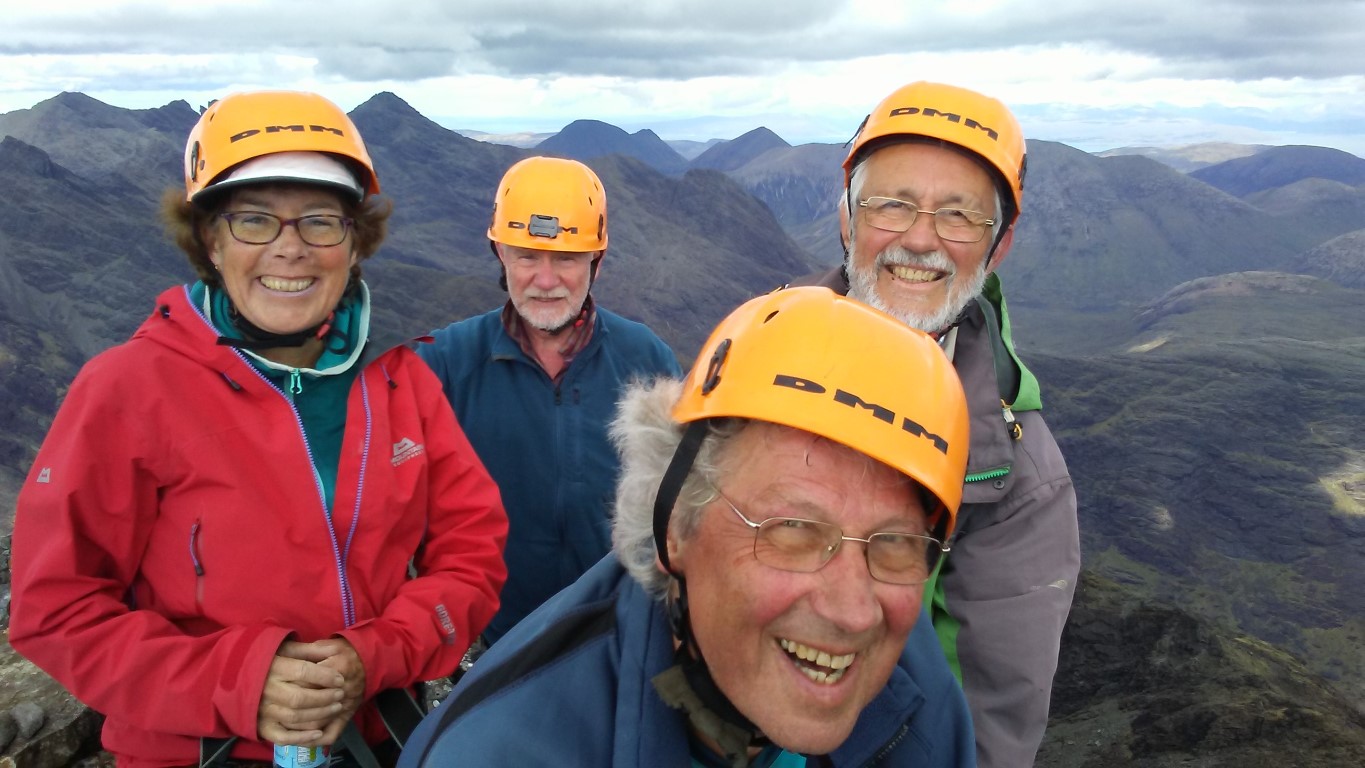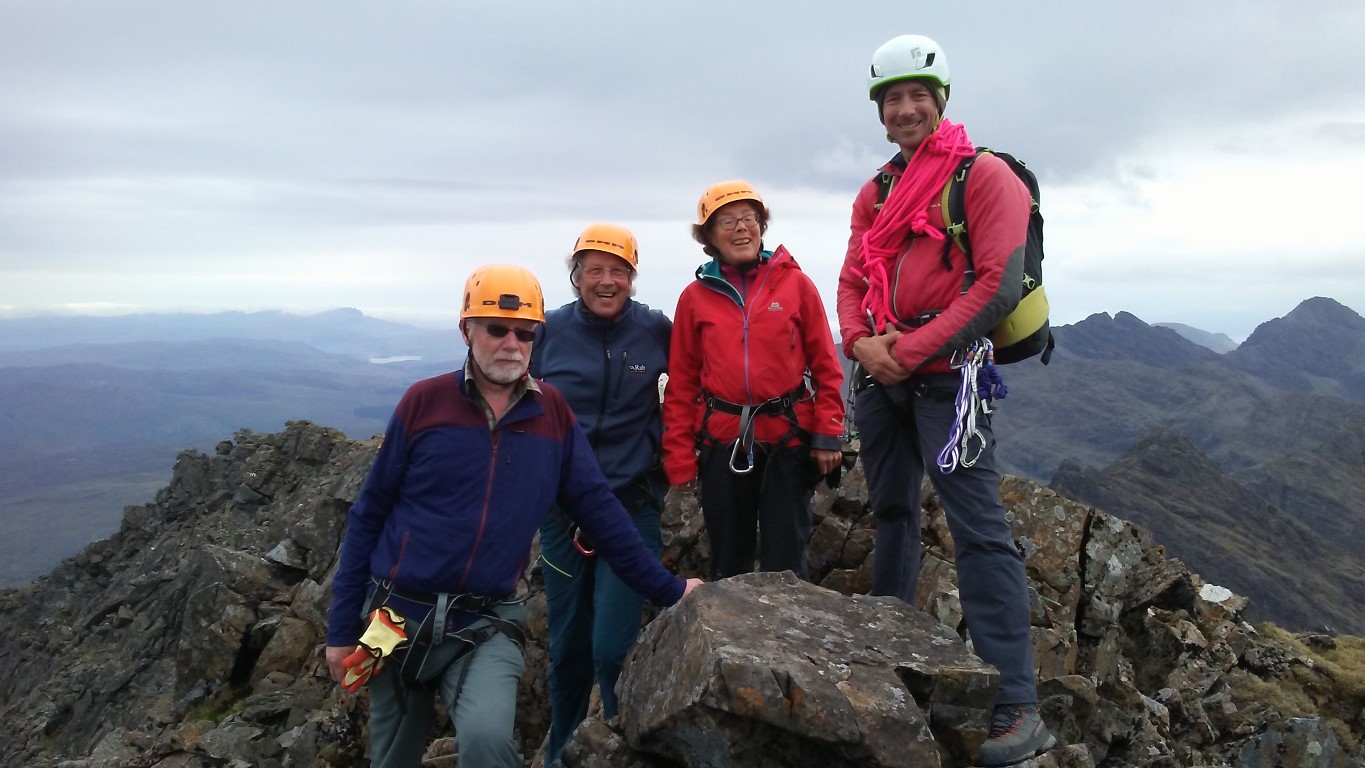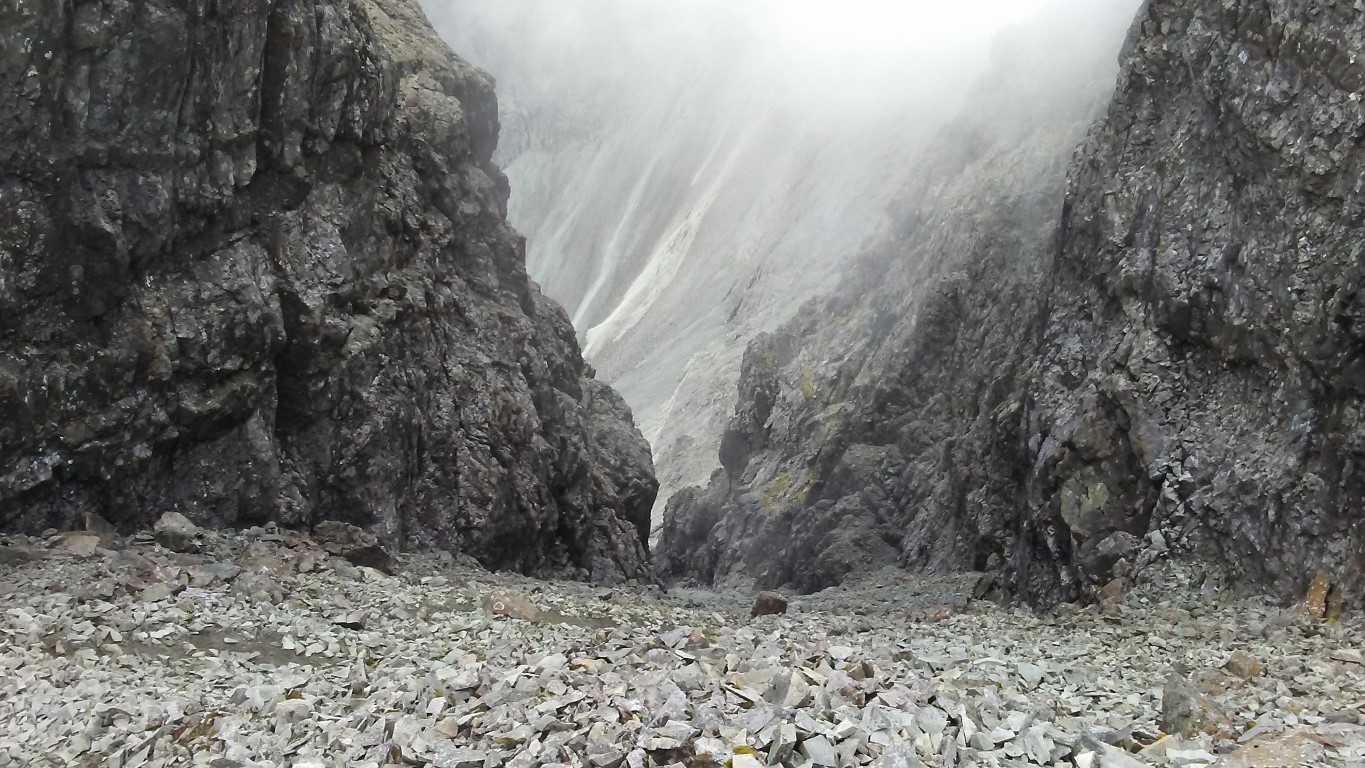So what is the Black Cuillin? It might be only seven miles long but this formidable chain of jagged peaks on the Isle of Skye is like no other in the British Isles and contains eleven Munro summits. The rocky summits tower skywards above sheer rock faces and consist of a complicated mix of the volcanic rock known as gabbro intruded with basalt dykes and several other rarer rocks including the very metallic peridotite which play havoc with your compass bearing. Knocking two pieces of peridotite together gives very much a metallic chink. The gabbro is very coarse and gives a good grip but the basalt becomes slippery when wet so it is idea to distinguish what you are walking on.
So here we are, four members of the East Cheshire Ramblers about to embark on quite an adventure. Due to the nature of the Cuillin’s we have hired a guide not only lead us up and down through the maze of crags but also to lead us roped up through trickier areas and to oversee and help us down anything we need to abseil.
For myself, I had only been up one of the Munro’s on Skye and that was the outlier of Blaven many years ago but for all of us, this was a new area to us all.
It’s a Saturday in May and the fine weather of the past week is at an end. Gathering at The Sligachan Hotel which everyone calls ‘The Slig’ we meet our guide for the next four days Tom who works for West Coast Mountain Guides. Like every day, it’s going to be an early start.
The weather forecast which as we find out is not always that accurate suggests that today will be the worst day of the next four so we opt to do the easiest walk of the four days to ease our way in and get a feel to the area. With Tom on board, we travel in one car to the start and today’s walk will be to scale two Munro’s – Sgurr a’ Ghreadaidh 973 metres then Sgurr a’ Mhadaidh 918 metres.
Setting off from Glen Brittle Youth Hostel our rucksacks are filled of not the usual items. This time we have to stuff in a hard hat, and harness together with an array of carabiners. Out goes my heavy camera – I will have to make do with my phone camera and hence the quality of my photographs won’t be quite as good. I don’t even need a map. For myself, it feels a bit strange going into a mountainous area without a map but we have full confidence in Tom.
At a steady pace we trek uphill beside the Allt a’ Choire Ghreadaidh with Tom leading our little group and after a good hour and a half we are well up into Coire An Dorus. Ahead lies a narrowing stone shoot leading up to the narrow gully leading to the An Dorus Gap which will ultimately lead up to both Munro’s. After a brief break it’s time to put on our yellow hard hat and get kitted up with our harnesses. Tom produces a rope and links us all up to give us practice of walking with a rope as a group. The rope needs to be kept taut. For now the yellow hard hat will give us some protection from any loose rock from falling from above. As we gain height so the stone shoot narrows and we have some easy scrambling up over some bigger rock steps. The crest of the ridge comes very suddenly with a steep drop going down the far side over rocky crags towards Loch Coruisk. It’s here that we are going to leave our rucksacks to tackle Sgurr a’ Ghreadaidh.
From An Dorus Gap there is a rock wall on either side. Tom leads out to belay some fifty feet about and shouts down for us to start climbing. Roped together means progress is slow. The key is remembering how Tom tackled this first bit and where do you put your feet. One by one we work our way up this first bit of somewhat awkward rock face. Beyond, the steep ascent continues but for much of the way is just a scramble except for a couple of awkward steps. It’s our first experience of being somewhere with a big drop below. A large rocky tower, known locally as ‘The Wart’ is skirted around on the western side to gain the tiny summit. It’s one summit down and ten to go. And yes we have got a view despite the grey overcast day.

The route taken up and down Sgurr a’ Ghreadaidh. Note the party making the ascent as we did a hour or so earlier.
Our route back is as our upward route except this will involve what is known as ‘down climbing’. With me roped up at the rear of the group on the way up it now my turn to lead and remember our upward route on the way down. It’s not as easy as you think as you are often climbing down semi blind feeling for good rock steps to ease your way down. It helps to lean out and to look down to get an idea where you are going. For everyone else you can guide them down, sometimes by catching hold of an ankle above you and guiding a foot onto a rock step. Meanwhile Tom at the top has secured the rope before climbing down himself.
Climbing out of the gap on the other side, this time with rucksacks also involves a short climb but we are soon on ‘easier’ ground if you can call it easier where we stop for a short lunch break. Coming to lunch breaks – stops were always very short and time only to grab a sandwich and a quick drink before we are off again.
Sgurr a’ Mhadaidh, our second Munro of the day proves more of a straightforward ascent. We were no longer roped up which made progress is much quicker. Dumping our rucksacks once more we scrambled up among the crags and were soon on this second airy summit. Again we are fortunate enough to get good views. The promised rain is nowhere to be seen.
Retracing our steps we were soon reunited with our rucksacks and time for another quick snack. Tom now searches out a easier route down to the An Dorus Stone Shoot where we descend as per our outward route.
We reached Glen Brittle Youth Hostel by mid afternoon and Tom has been pleased at our progress.
It’s day two and after the first successful day on the Black Cuillin, the weather has taken a turn for the worst. The weather forecast suggests that it will improve as the day goes on and fingers crossed the low cloud will lift off the mountains. As usual it’s a early start and we meet up with Tom at ‘The Slig’. Putting off the infamous ‘In Pinn’ for a better day we opt to do the three northernmost Munro’s – Bruach na Frithe, 958 metres, Am Basteir 935 metres and Sgurr nan Gillean 965 metres.
From the word go, the weather doesn’t look good with steady fine rain and the mist and murk well down on the mountains. It’s a case of donning wet weather gear even when we start.
It’s a long walk in but it’s a good path to follow and it seems that we are the only ones setting out this morning. It’s such a pity that we have no views as the landscape ahead is quite spectacular with the pinnacle ridge of Sgurr nan Gillean towering ahead and to our left. As we gain height so that landscape gradually mists away. Reaching the western side of the Bhasteir Gorge we now need to clamber up to our right. There are several rock terraces and it’s very easy to take the wrong one. Tom scouts on to check that the route ahead the correct one. Once over this area we enter the hanging valley of Coire a Bhasteir but little can be seen. The whole place is choked withthick mist. Tom leads us up among scree slopes and crags towards the northern precipitous face of Am Basteir with a brief stop to put on hard hats. Conditions are certainly not improving and the fine rain at the foot of the mountain has turned to steady rain.
The decision is made to get to the top of Bruach na Frithe first which is the easiest of the three Munro’s planned for today. Dumping rucksacks, we toil up the steep scree slope below the overhanging northern face of Am Basteir and the cliffs are giving some shelter. The Bhasteir Tooth rises skyward into the mist but we do get an misty outline of this in the thick mist. Beyond, we round a craggy top before scrambling along to the summit of Bruach na Frithe. Crowned with a trig point it is the only summit with a trig point in this group of eleven Munro’s. It’s just unfortunate that the view is simply nil today.

The summit of Bruach na Frithe. The only summit in the Black Cuillin with a trig point but today there was simply no view.
We pick our way back along the ridge and down to our rucksacks for our lunch stop in the rain. The rocks are all running with water and in a discussion over lunch we opt to abandon any attempt on scaling anymore Munro’s today. It does mean now that we will not achieve our target of doing all eleven Munro’s on this trip but having said that, few groups are successful in completing all these Munro’s on one trip. The weather needs to be on your side and secondly the party needs to be very fit.
Disappointed we head back downhill crossing a stream that has swollen in the past three hours. We are all quite damp and glad to get back for a decent shower and freshen up. So we are half way through our course but only three Munro’s climbed.
It’s the penultimate day and despite not a very promising start weather wise we opt for the longest walk of the four days. It’s just three of us today plus our guide as Monica has been attracted to the bright lights of Portree. Again we collect Tom from ‘The Slig’ and travel down to the camp side above Glen Brittle Beach.
It’s a early start with three Munro’s ahead of us with Sgurr nan Eag 924 metres on the cards first, followed by Sgurr Dubh Mor 944 metres and a ascent of Sgurr Alasdair 993 metres to finish with.
It’s a long walk in over relatively easy ground and slowly ascending with increasingly good views out to sea to Rum, Eigg and Tiree with the Outer Hebrides on the far horizon. To the west it is quite sunny but showers are building up already with a few shafts of rain falling here and there. After a good two miles we start to head up into Coire Ghrunnda and the terrain soon becomes steep with a jumble of house size boulders to negotiate. Tom has a good balance and is able to walk from boulder to boulder with confidence but the rest of us take on this part a bit more caution. A further steep rocky ascent which requires a bit of knowhow on way finding climbs up to a second hanging corrie and Loch Coir a Ghrunnda. It’s time for a short morning break before skirting the loch and pressing up the scree and crag slope over increasingly difficult ground. Nearing the crest of the ridge it’s time to dump rucksacks before picking our way along the airy ridge to Sgurr nan Eag where we get a excellent view. The hill cloud of earlier is lifting off the tops. It’s now a case of returning to our rucksacks.
With a quick bite to eat we are off again bound for Sgurr Dubh Mor and this section of the walk proves quite tricky. Although we do manage to bypass the rock stack called Caisteal a Garbh-choire. The route chosen is called the ‘Runners traverse’ which skirts along the eastern side of several crags and this proves a little used route and involved a fair bit of scrambling.
On the ridge west of Sgurr Dubh Mor the rucksacks are left again before making quite a difficult ascent to this summit which involves a few awkward moves and working your way up a chimney. This summit lies off the main Cuillin ridge and it proves time consuming to reach. Roped up, Rob leads us down towards our rucksacks but takes us out onto an airy ledge which we decide to call Rob’s Traverse – an airy little walk with a big drop but good hand holds. It is like standing on the window sill of a three story building!
Re-united with our rucksacks, it is time to bag the last summit of the day and the highest in the Cuillins. To get to the summit of Sgurr Alasdair meant skirting along the southern flank below sheer cliffs on a steep scree covered slope to gain the south western ridge via a ‘chimney’ not far from the summit. The chimney proves a hard climb and in places we have to use our feet on one side and our back on the other to work your way up. As usual Tom was always above with the rope secured. The last little bit is an airy scramble to the tiny summit with the ground falling away either side into the abyss.
For a few minutes we were the highest people in the Hebrides. Now for the descent which means working our way along a narrow rocky ridge down to the top of the Great Stone Shoot where we stopped for a break. Hemmed in by the rock walls of Sgurr Alasdair on one side and Sgurr Thearlaich on the other, The Great Stone Shoot is the longest scree slope in Britain but the angular stones come in all shapes and sizes, with the stones at the bottom generally smaller. The descent is incredibly steep and once in motion it is difficult to stop. This is where our builder gloves come in handy as virtually no one descends this steep slope without sliding down on their backside.
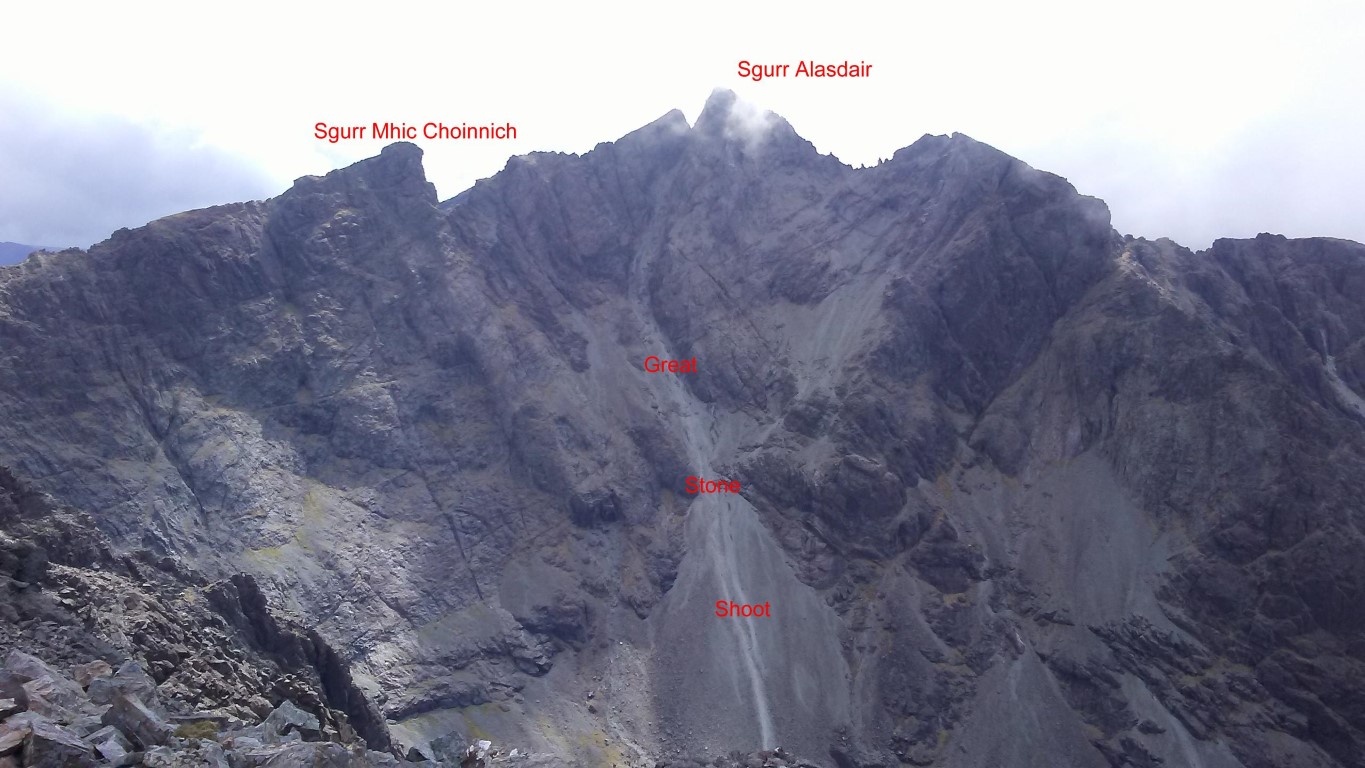
The view of the Great Stone Shoot taken on the following day. We descended this route from Sgurr Alasdair. At nearly 2000 feet it is the longest scree slope in Britain as is incredibly steep.
Some of us were quicker than others and others (not in our party) spent more time on their rear coming down. The hard hats are essential and it was well advised to keep well apart from anyone else due to the amount of loose stone. Safely at the bottom we are reunited for the walk back to the car and a later than usual finish and our tally on the Cuillin Munro’s now totalled six.
Monica has rejoined us for the last day and we are now faced with our greatest challenge. The ascent of the Inaccessible Pinnacle 986 metres and Sgurr Mhic Choinnich 948 metres rated as first and second hardest Munro’s to climb.
From the start we have ruled out climbing Sgurr na Banachdich, – a Munro but a much easier one which can be reached without a guide. The decision is taken to climb directly from the Glen Brittle Memorial Hut up the western ridge of Sgurr Dearg and going via this route we gain height quickly. The ascent is fairly straightforward with just a little easy scrambling among the crags higher up. Other groups have set out before us and so are expecting a queue to climb the In Pinn. At least today, the visibility is excellent and away from the mountainous areas it is quite sunny.
We reach the top of Sgurr Dearg before noon and made the down climb of steep sloping rock with loose scree to the base of the In Pinn. In the silence of the late morning some thousand feet below us comes the sound of crashing rock and as we find out later, several hundred tonnes of rock had come away from the mountain side and has scattered down the steep slope. The biggest pieces are the size of a bus so we were just glad we were not in that area at the time. With Monica and myself reaching the point where we have to make the climb of the In Pinn first, Tom decides to lead us first as there is no queue. Meanwhile Nick and Rob will have lunch and await for our return. The Matterhorn and most Alpine peaks were conquered before the In Pinn and it wasn’t until 1880 that the In Pinn was finally climbed by Charles and Lawrence Pilkington. They were guided to the foot of the climb from Sligachan via Coruisk and Bealach Coire na Banachdich by a local shepherd called John Mackenzie.
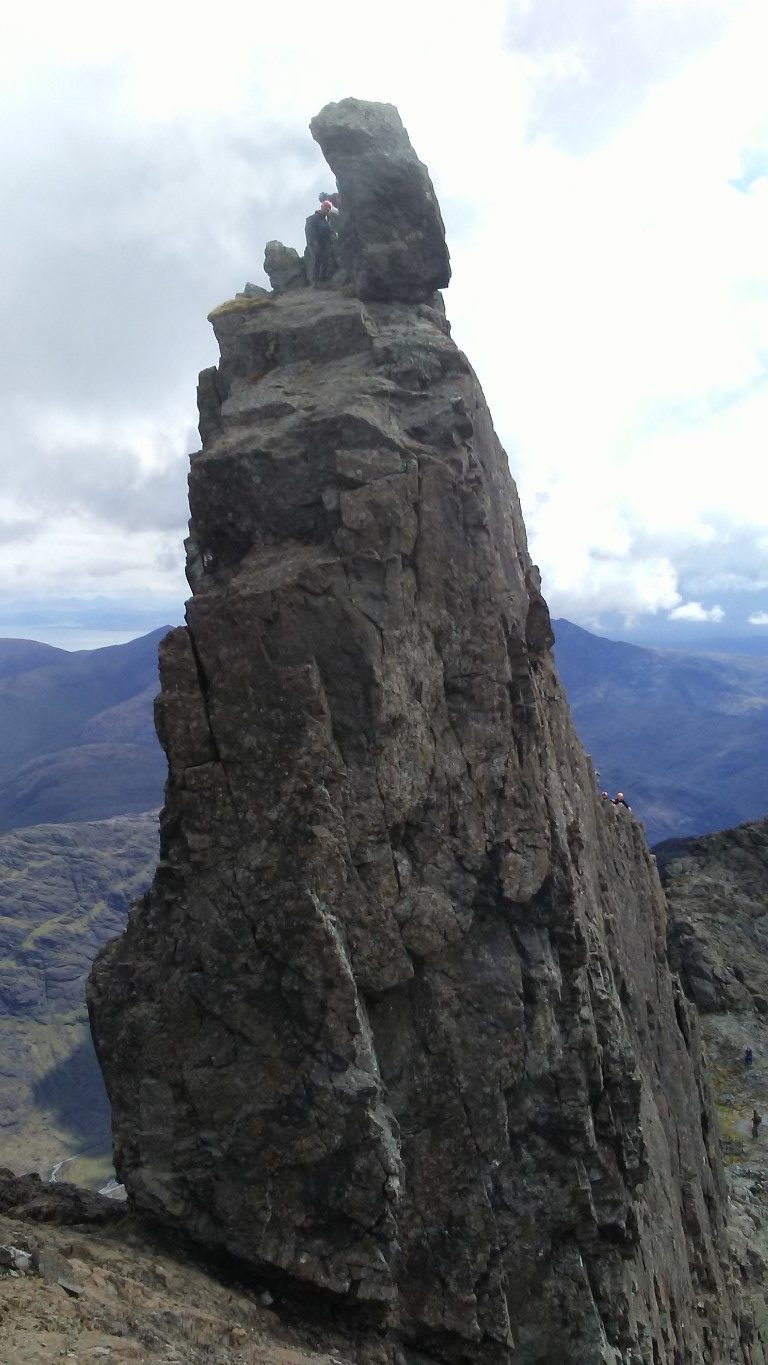
Our first view of the ‘In Pinn’. Note the climber on top. We will abseil off this side later. We will ascend via the ‘easier’ far side.

The side we ascended The ‘In Pinn’. monica can be seen in the stone shelter, bottom left. the ascent is very exposed on either side so best not attempted in wet and or windy weather.

Nick followed by Rob on the first pitch of the ‘In Pinn’. The guide only takes two of us up at any one time. Tom our guide is out of sight just over the pinnacle.

The view on top of the ‘In Pinn’ looking southeast. Being roped up and constantly on the move there are few precious moments to get photographs.
Tom sets off up the knife edge ridge to secure the rope for the first pitch and we watch carefully where Tom is placing his feet. Monica and I are attached on the rope at the bottom with Monica taking the lead. I follow on behind at the end of the rope. The first thirty feet is fairly straightforward but then you have to get onto the knife edge ridge with hand and footholds quite smooth over time. Re-united briefly with Tom he then climbs the second pitch whilst Monica and I cling on the narrow ledge above the abyss. Tom shouts down to start climbing. It is getting airy with an overhanging and infinite drop on one side, and a drop on the other side even steeper and longer. Now concentrating on what I am doing and planning each step is paramount. Now I know that climbing shoes are better than walking boots in this type of terrain. The footholds are so small that below the soles of my boots are hundreds of feet of air! I cling on trusting that my hands will hold as the knife edge steepens and daring not to look down. Thankfully the ridge eases but at the same time gets much narrower as we make our way to the airy summit with much relief.
It is now time to abseil down the steep side, an eighteen metre sheer rock face. Tom is going to do a stacked abseil meaning we would all go down the same rope. The massive rock on the summit has a fixed chain around it with carabiners which you can attach the rope. Now I am thankful that I had abseiled before and I am more confident for the descent. Tom descends first with me following and remembering what I had learnt on Tegg’s Nose a few weeks earlier. Lean well back, feet apart and let the rope feed through your hands as you walk backward down the rock face. It is all over in a moment with feet firmly on terra firma. Monica follows confidently and at speed and the three of us make our way back to Nick and Rob.
It is now their turn and again Tom leads on up the rock face before Nick and Rob start out on their ascent. Meanwhile Monica and I settle down to lunch in the shelter of a dry stone wall but it seems a long time before the three of them return and we are beginning to get cold.
We are glad to set off and made our way slowly down to the col above An Stac screes. On the way we pass the massive rock fall from a couple of hours earlier which lay right on our path and it seems that more rock is ready to fall, hence we don’t hang about here.
Dumping rucksacks we will now attempt the climb of Sgurr Mhic Choinnich which is said to be the second hardest Munro in the Black Cuillin. there are certainly some very airy drops as you work your way along the ridge.

On the summit of Sgurr a’ Ghreadaidh with the view towards Sgurr Thearlaich and Sgurr Alasdair. note the climber at the summit.
Near the col we pause awhile and leave the rucksacks weighted down with a few rocks before making the ascent on the complicated Sgurr Mhic Choinnich. The summit is said to be the second hardest Munro to climb in the country and route finding proves not easy. For much of the way we are roped together and Tom opts to keep us right on the crest which in places has an almost sheer drop of several hundred feet on the western side. The summit is narrow with smooth steep slopes on either side almost as if you were on the apex of a rouse with steeply sloping roofs.

The red arrows show the route taken from Sgurr Dearg and The In Pinn to the top of the An Stac screes. there had been a rock fall of several hundred tonnes a couple of hours prior to this photograph being taken.
For the return, I lead the way, picking my way along the crest and all the time we are roped up. I find a ‘chimney’ which seems an easier route and once in it we are committed until we can gain the ridge again. Back with our rucksacks after what seems to be quite a long time we take a break before descending the An Stac screes which although much shorter than the Great Stone Shoot we still end up with us well spaced out. The walk out was from Loch Coire Lagan is noted for its smooth rock gouged out by glaciers.
 Smooth rock gouged out by glaciers make these features look a bit out of place. This rock looked like a stranded whale. This photograph was taken in Coire Lagan on our last day in the Black Cuillins. The Cioch is shown up by the shadow it is casting on the rock face.
Smooth rock gouged out by glaciers make these features look a bit out of place. This rock looked like a stranded whale. This photograph was taken in Coire Lagan on our last day in the Black Cuillins. The Cioch is shown up by the shadow it is casting on the rock face.
High to our left we spot two climbers high up on the rock face called The Cioch. This is a massive piece of rock which almost defies gravity and sticks out of the rock face. In 1986 it featured as the setting for a sword-fight in the movie ‘Highlander’. Our pace now quickens as we gain easier ground and in afternoon sunshine make our way back to the Glen Brittle Memorial Hut.
Overall we had bagged eight of the eleven Munro’s we had set out to do and the weather has been kind to us on three of the four days. I understand that you could go to the Cuillins and bag no Munro’s if the weather was bad and so overall we haven’t done too bad. Having said that, we are all very grateful to our guide, Tom Sylvester which without him, this adventure would not have been possible.

